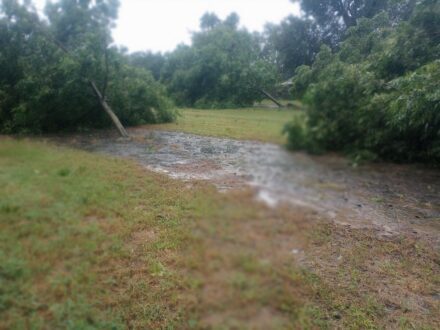Major agricultural counties in Georgia hit hard by Hurricane Idalia
The federal government has approved disaster declarations for three south Georgia counties — two of which are major vegetable, berry, peach and pecan producers — in the wake of Hurricane Idalia.
Cook, Lowndes and Glynn counties received the declaration on Sept. 7. In response to Governor Brian Kemp’s request, President Joe Biden approved the disaster declaration allowing residents the affected counties access to emergency relief funds following the significant damage caused by Hurricane Idalia.
South Georgia is the second of two of the state’s commercial peach growing regions. Blueberries are also a big crop in the region.
In south-central Georgia, home of Valdosta and Lake Park, Lowndes County is a leading pecan producing county and is ranked ninth in the state for growing vegetables, melons and potatoes and 20th in tree fruits, berries and nuts, according to the Georgia Department of Agriculture.

Lowndes County’s northern neighbor, with Adel its major city, Cook County is ranked 14th in vegetables, melons and potatoes and is a major sweet corn growing region. Along the Atlantic Coast, Glynn County, home of Brunswick, is ranked 123rd in the state for tree fruits, berries and nuts.
As damage assessments continue in other areas affected by the storm, Agriculture Commissioner Tyler Harper and GDA will continue to work with federal, state and local leaders to push for an expanded disaster declaration for all impacted counties, according to a news release.
Cook, Glynn, and Lowndes Counties are home to more than 650 agricultural operations farming more than 140,000 acres with a farmgate value of more than $120 million. Additionally, GDA licenses and regulates 1,858 entities across those counties, including livestock and poultry operations, retail grocery stores, meat processing facilities, gas stations, animal shelters, and others. This declaration allows farmers, small-business owners, and other GDA regulated entities to apply for emergency disaster relief.
 Assistance can include grants for temporary housing and home repairs, low-cost loans to cover uninsured property losses, and other programs to help individuals and business owners recover from the effects of Hurricane Idalia.
Assistance can include grants for temporary housing and home repairs, low-cost loans to cover uninsured property losses, and other programs to help individuals and business owners recover from the effects of Hurricane Idalia.
Federal funding is also available to state and eligible local governments and certain private nonprofit organizations on a cost-sharing basis for debris removal and emergency protective measures. Additionally, federal funding is available on a cost-sharing basis for hazard mitigation measures statewide, according to the release.
Residents and business owners who sustained losses in the designated areas can begin applying for assistance at DisasterAssistance.gov, by calling 800-621-FEMA (3362), or by using the FEMA App.
“Supporting Georgia agriculture is not about politics — it’s about doing the right thing on behalf of Georgia’s farmers and farm families, and while this declaration is a welcome first step, we remain committed to ensuring it’s expanded to include all impacted counties,” Harper said in the release. “I’m grateful that President Biden and his Administration moved swiftly to approve Governor Kemp’s request for a disaster declaration and look forward to continuing our work alongside federal, state, and local leaders to expand the declaration to all counties impacted by Idalia.”










